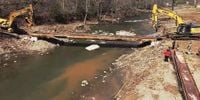One year after Hurricane Helene tore through North Carolina, the scars left by the storm are still painfully visible in communities across the state. On September 24, 2025, the anniversary of Helene’s landfall, the sense of urgency is palpable: battered roads, destroyed homes, and families still waiting for help. As state and federal officials tout new initiatives and debate disaster policy, many North Carolinians find themselves stuck in limbo—caught between the slow churn of bureaucracy and the immediate need to rebuild.
According to NPR, Hurricane Helene was a disaster of historic proportions. The storm claimed more than 100 lives and left entire communities in Western North Carolina devastated. The effects were widespread: over 5,000 miles of roads were damaged, forcing closures and making travel a daily challenge for residents. In the small mountain community of Bat Cave, for example, locals like Sherry Murphy and Suzette Dupuis have spent months navigating crumbling one-lane roads, pitching in to help neighbors and state contractors alike. “There’s nothing better than to see the smile on these guys’ face and knowing that we’re going to be here till the end,” Murphy told Blue Ridge Public Radio. But as she and others know too well, that end seems a long way off.
For many, the biggest obstacle isn’t the physical devastation—it’s the wait for federal support. Local governments have shelled out millions for emergency repairs, often dipping deep into their limited budgets. According to Governor Josh Stein, Henderson County alone spent $20 million clearing debris, a sum that amounts to 10% of its annual budget. “Western North Carolina towns and cities were forced to spend money that they didn’t have to rescue people from disaster,” Stein said. The state is still waiting for federal reimbursements for much of the work already completed. Of the estimated $5 billion needed for road repairs, the Federal Emergency Management Agency (FEMA) has disbursed just $100 million—about 10% of North Carolina’s costs so far. FEMA has not clarified how much more aid will be provided or when it might arrive.
Meanwhile, the financial strain is compounded by a series of policy setbacks at both the state and federal levels. In a commentary published by the Environmental Defense Fund (EDF), Will McDow, Associate Vice President for EDF’s Climate Resilient Coasts and Watersheds initiative, painted a stark picture of the challenges facing North Carolina. McDow points to the 2023 Supreme Court decision in Sackett v. EPA, which severely limited federal protections for wetlands. “Research by Environmental Defense Fund scientist Dr. Adam Gold shows that 500,000 to 3.6 million acres of wetlands in North Carolina may no longer be protected depending on federal and state rules,” he wrote. With the Environmental Protection Agency proposing a broad interpretation of the ruling, more than 3 million acres of wetlands could now be vulnerable—putting even more communities at risk of future flooding.
Wetlands are a natural line of defense against hurricanes and floods. Losing them, experts warn, could spell disaster for low-lying communities already struggling to recover. “With the EPA proposing an extreme interpretation of the Sackett decision, more than 3 million acres of wetlands across North Carolina could now be destroyed, putting more people and communities at-risk of flooding,” McDow explained. The timing couldn’t be worse, as disaster preparedness programs are also being slashed.
One such program, FEMA’s Building Resilient Infrastructure and Communities (BRIC), was created in 2018 with bipartisan support. It funded projects to build flood protection and resilient infrastructure—initiatives that, according to the EDF, saved $13 in avoided damages for every dollar invested. Yet, earlier this year, the program was defunded, halting at least $164 million in projects that had already been selected for North Carolina. “That’s money that would have protected families, businesses and tax dollars from future storms,” McDow argued. “Instead, communities remain exposed, and recovery costs will only rise.”
FEMA itself has faced criticism for scaling back its support. The agency ended its door-to-door outreach in disaster areas, making it harder for vulnerable residents—especially the elderly and those without transportation—to access aid. Local and state governments are now expected to front recovery costs while waiting for FEMA reimbursements, a process that can drag on for months or even years. For smaller towns operating on shoestring budgets, the burden can be overwhelming.
In response to these challenges, state officials are stepping up with their own initiatives. On September 24, 2025, Governor Josh Stein announced a new $50 million state-funded grant program to support local governments in their recovery efforts from Hurricane Helene. Dubbed the Helene Local Government Capital Grants, the program is administered by the Office of State Budget and Management and is open to local governments and federally recognized tribes with capital improvement needs arising from the hurricane. To be eligible, projects must be located in FEMA-designated disaster areas and must have been denied FEMA Public Assistance reimbursement. Grant awards are subject to statutory caps per recipient and county, and the deadline for applications is November 21, 2025.
“We’re still waiting on reimbursements for much of the work that’s already been done,” Stein said in a statement, echoing the frustrations of local officials across the state. “West North Carolina has not received anywhere near what it needs, nor our fair share.” Despite the new state grant program, many worry that the funds will be a drop in the bucket compared to the billions still needed for full recovery.
At the federal level, there are signs of bipartisan momentum to address some of these issues. Earlier this month, a U.S. House of Representatives committee advanced the FEMA Act by a vote of 60-3. The legislation aims to establish FEMA as a cabinet-level agency and make changes to pre- and post-disaster policies, programs, and processes. The goal: to simplify disaster assistance for victims, incentivize preparedness, improve coordination among federal agencies, and increase transparency and accountability. North Carolina Representatives Rouzer, McDowell, and Foushee all voted in favor of the bill, while Representative Edwards is a co-sponsor.
Still, the road to recovery is long and uncertain. Volunteers and neighbors continue to fill the gaps left by government programs, delivering home-cooked meals to workers and supporting each other through the slow rebuilding process. As one resident put it, “We’re going to be here till the end.” But with wetlands protections eroding, disaster funding in flux, and federal aid slow to arrive, the future remains precarious for North Carolina’s hardest-hit communities.
For now, the lessons of Hurricane Helene are stark: proactive investment in disaster resilience is far cheaper—and far kinder—than scrambling to rebuild after the storm has passed. North Carolina has weathered many storms before, but the cost of inaction is growing higher with each passing year.




